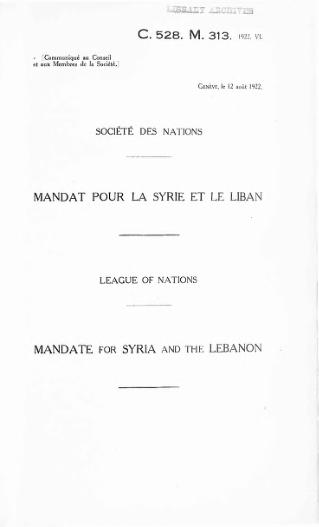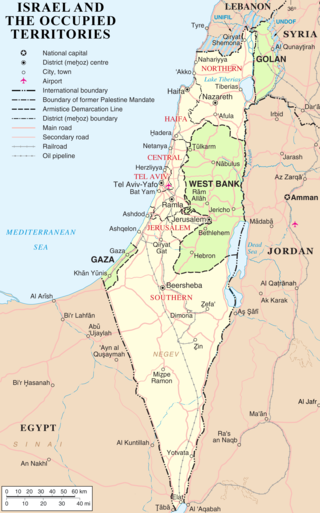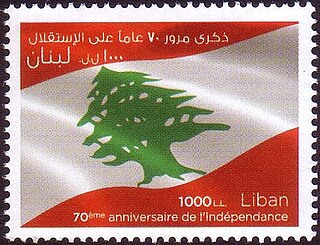The Eastern Caribbean dollar is the currency of all seven full members and one associate member of the Organisation of Eastern Caribbean States (OECS). The successor to the British West Indies dollar, it has existed since 1965, and it is normally abbreviated with the dollar sign $ or, alternatively, EC$ to distinguish it from other dollar-denominated currencies. The EC$ is subdivided into 100 cents. It has been pegged to the United States dollar since 7 July 1976, at the exchange rate of US$1 = EC$2.70.
The Kwacha is the currency of Zambia. It is subdivided into 100 Ngwee.

The pound sterling is the official currency of the United Kingdom, Jersey, Guernsey, the Isle of Man, British Antarctic Territory, South Georgia and the South Sandwich Islands, and Tristan da Cunha.

The Syrian pound or lira is the currency of Syria. It is issued by the Central Bank of Syria. The pound is nominally divided into 100 piastres, although piastre coins are no longer issued.

The Mandate for Syria and the Lebanon was a League of Nations mandate founded in the aftermath of the First World War and the partitioning of the Ottoman Empire, concerning Syria and Lebanon. The mandate system was supposed to differ from colonialism, with the governing country intended to act as a trustee until the inhabitants were considered eligible for self-government. At that point, the mandate would terminate and a sovereign state would be born.

The franc was the currency of Madagascar until 1 January 2005. It was subdivided into 100 centimes. In Malagasy the corresponding term for the franc is iraimbilanja, and five Malagasy francs is called ariary.

The Palestine pound was the currency of the British Mandate of Palestine from 1 November 1927 to 14 May 1948, and of the State of Israel between 15 May 1948 and 23 June 1952, when it was replaced with the Israeli pound.

Banque du Liban is the central bank of Lebanon. It was established on August 1, 1963, and became fully operational on April 1, 1964. In 2023, Wassim Mansouri stepped up as interim governor of the Banque du Liban after Lebanon failed to name a successor to Riad Salameh, whose term finished in July 2023. Salameh, who was chairman for 30 years, has been accused of corruption, money laundering and running the largest Ponzi scheme in history; he was additionally labeled "the world’s worst central banker". He is currently under sanctions by Canada, the United Kingdom and the United States.

The Ottoman Bank, known from 1863 to 1925 as the Imperial Ottoman Bank and correspondingly referred to by its French acronym BIO, was a bank that played a major role in the financial history of the Ottoman Empire. By the early 20th century, it was the dominant bank in the Ottoman Empire, and one of the largest in the world.

The lira or pound is the currency of Lebanon. It was formerly divided into 100 piastres but, because of high inflation during the Lebanese Civil War (1975–1990), subunits were discontinued.

The Central Bank of Syria is the central bank of Syria. The bank was established in 1953 and started operations in 1956. Its headquarters are in Damascus, with 11 branches in the provincial capitals. The objective of the bank is "to foster the stability, integrity and efficiency of the nation’s financial and payment systems so as to promote optimal macro economic performance".

The modern borders of Israel exist as the result both of past wars and of diplomatic agreements between the State of Israel and its neighbours, as well as an effect of the agreements among colonial powers ruling in the region before Israel's creation. Only two of Israel's five total potential land borders are internationally recognized and uncontested, while the other three remain disputed; the majority of its border disputes are rooted in territorial changes that came about as a result of the 1967 Arab–Israeli War, which saw Israel occupy large swathes of territory from its rivals. Israel's two formally recognized and confirmed borders exist with Egypt and Jordan since the 1979 Egypt–Israel peace treaty and the 1994 Israel–Jordan peace treaty, while its borders with Syria, Lebanon and the Palestinian territories remain internationally defined as contested.

The State of Aleppo was one of the six states that were established by the French High Commissioner of the Levant, General Henri Gouraud, in the French Mandate of Syria which followed the San Remo conference and the collapse of King Faisal I's short-lived Arab monarchy in Syria.
This is a survey of the postage stamps and postal history of Syria.

This is a survey of the postage stamps and postal history of Lebanon, formerly known as Liban.

The Second Syrian Republic, officially the Syrian Republic from 1950 to 1958 and the Syrian Arab Republic from 1961 to 1963, succeeded the First Syrian Republic that had become de facto independent in April 1946 from the French Mandate. The Second Republic was founded on the Syrian Constitution of 1950, which was suspended from 1953 to 1954 under Adib Shishakli's strongmanship, and later when Syria joined with the Republic of Egypt in forming the United Arab Republic in 1958. The Second Republic resumed when Syria withdrew from the union in 1961. In 1963, the Syrian Ba'athist Party came to power in a bloodless military coup, which laid the foundations for the political structure in Ba'athist Syria.

The State of Syria was a French Mandate state created by decree of 5 December 1924, with effect from 1 January 1925, from the union of the State of Aleppo and the State of Damascus. It was the successor of the Syrian Federation (1922–1924) which had been created by providing a central assembly for the State of Aleppo, the State of Damascus and the Alawite State. The Alawite State did not join the State of Syria.

The First Syrian Republic, officially the Syrian Republic, was formed in 1930 as a component of the Mandate for Syria and the Lebanon, succeeding the State of Syria. A treaty of independence was made in 1936 to grant independence to Syria and end official French rule, but the French parliament refused to accept the treaty. From 1940 to 1941, the Syrian Republic was under the control of Vichy France, and after the Allied invasion in 1941 gradually went on the path towards independence. The proclamation of independence took place in 1944, but only in October 1945 was the Syrian Republic de jure recognized by the United Nations; it became a de facto sovereign state on 17 April 1946, with the withdrawal of French troops. It was succeeded by the Second Syrian Republic upon the adoption of a new constitution on 5 September 1950.

Banking in Syria is controlled by the Central Bank of Syria which also controls all foreign exchange and trade transactions. All commercial banks in Syria were nationalised in 1966. The Central Bank gives priority to lending to the public sector, while the private sector often banks abroad, a process that is more expensive and therefore a poor solution to industrial financing needs. Many business people travel abroad to deposit or borrow funds. It is estimated that US$6 billion has been deposited by Syrians in Lebanese banks.

The Bank of Syria and Lebanon, from 1919 to 1924 Banque de Syrie, from 1924 to 1939 Banque de Syrie et du Grand-Liban, then Banque de Syrie et du Liban (BSL) from 1939 to 1963, was a French bank that was carved out from the Imperial Ottoman Bank following World War I and granted a central banking role in what would become Syria and Lebanon under French mandate and in the early years of the two countries' independence.
















